It is said that if you have the urge to know a place better, then explore its craft, food and the civilization there. Similarly, if you require knowing more about a craft, then come hang in with us, as we are going to walk you through the crafts that are magnanimous yet still obscure to many people.
Ajrakh is one of the most ravishing and radiant craft in today’s time for sure, but it has been around for quite some while now. Let's dive right in!
SHURUVAAT
Ajrakh initially originated from Sind, Pakistan, as a legacy of Indus valley civilization around 3000 BC. It later on extended to the provinces of Kutch, Gujarat and Rajasthan too. As it is believed and historians have also stated, ajrakh is an Arabic word, which means blue, which is one of the most prominent colors in its creation. Ajrakh printing blossomed in India in the 16th century with the migration of Khatris from the Sind to Kutch district. It is said that the king of Kutch acknowledged and recognized the textile art, and encouraged the migration of Khatris to uninhabited lands in Kutch. Some Khatri printer families migrated to Rajasthan too and settled in and around Barmer province, including present-day Gujarat, and excelled at the art of ajrakh printing.
KUDRAT KA DASTOOR
Ajrakh printing has glimpses of nature in its prints and motifs. The colours in this form of print deeply resonate with the natural colours of nature. While Red symbolizes the earth, indigo blue symbolizes twilight, and Black and white are used with a view to outline motifs and define symmetrical designs. Also, the use of Eco-friendly natural dyes is gradually coming back into view too. Craftsmen used indigo plants growing along the Indus river whereas red is acquired from alizarin found in roots of madder plants. Black is obtained from iron shavings or millet flour and molasses along with the addition of ground tamarind seeds to thicken the dye.
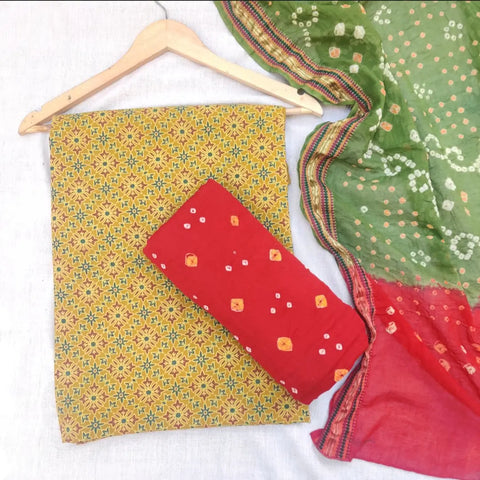
The contemporary ajrakh motifs have vibrant contrasting colours like rust, yellow and orange. Even in the motifs, the references of nature are evident as their jewel-like shapes symbolize natural elements like flowers, leaves and stars. The most common motif found in ajrakh printing is the trefoil which is made of three sun discs entangled together to represent the cohesive unit of the gods of earth, water and sun.
SOCH SE BANAVAT TAK
In the formation of any craft, what intrigues us the most is the fact of how it is actually formed. It definitely isn’t an easy task, rather it is one of the most sedulous tasks. The entire process is bifurcated into stages of work.
Saaj: The fabric is washed to remove starch and then dipped in a solution of camel dung, soda ash and castor oil and kept overnight. The next day, it is partially dried under the sun and then dipped in the solution again. This process of saaj is repeated about eight times until the fabric produces foam when rubbed. Finally, it is washed in normal water.
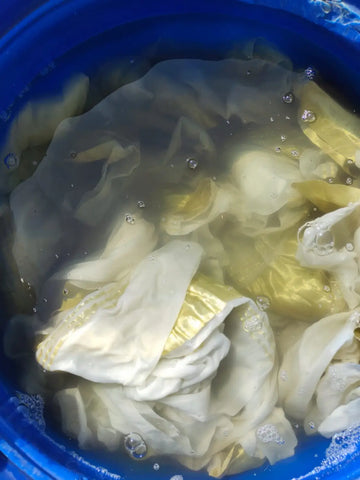
Kasano: The fabric is then boiled in a solution of myrobalan which is the nut from the hard tree. Myrobalan is used as the first in the dyeing process. Then , the fabric is dried under the sun on both sides.

Khariyanu: A resin of lime and babool tree resin is printed on to the fabric to outline the motifs that are required to be white. This printing is called rekh. The resist is printed on both sides of fabric using carved wooden blocks.
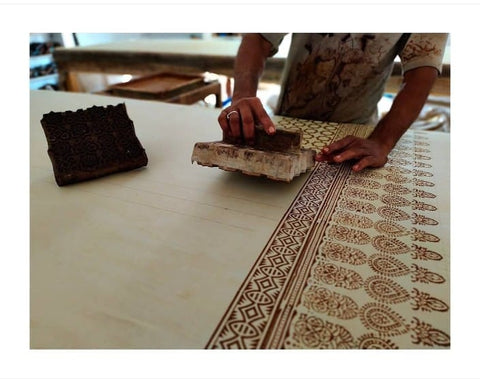
Kat: When a Scrap iron and jaggery are mixed with water and left for about 20 days, the water becomes ferrous. Then , the tamarind seed powder is added and the ferrous water is boiled to a paste known as kat and is printed on to both sides of the fabric.
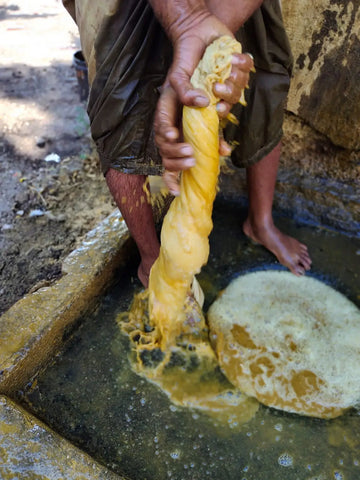
Gach: Clay, alum and gum Arabic are mixed to form a paste which are next to be used for the resist printing. This phase is known as gach. To prevent the clay from smudging, saw dust or finely ground cow dung is spread on the printed portion. After this, the cloth is dried naturally for about 7-10 days.
Indigo dyeing: The fabric is then dyed in indigo. Next, it is kept in the sun, to dry and then is dyed again twice to coat it uniformly.
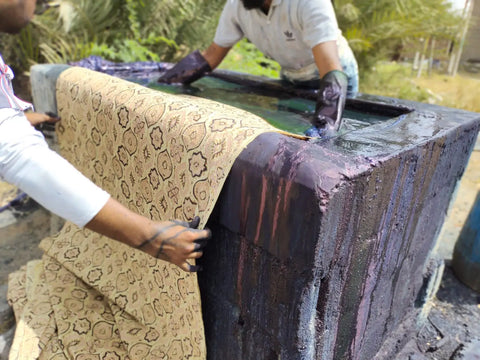
Vichcharnu: The fabric is washed thoroughly to remove all the resist print and extra residue of dye.

Rang: Next the fabric is put to boil with alizarin, i.e. synthetic madder , for a bright shining red colour to alum residue portion. The grey areas, from the black printing turn into a deeper hue. For other colours, the fabric is boiled with a different coloured dye. Madder root usually generates an orange colour, henna adds a light yellowish green colour, and rhubarb root gives a faint brownish colour.

This way, this process can consume up to two weeks, and consequently results in the formation of exquisitely beautiful and captivating designs of the ajrakh. Water here plays a vital role in ajrakh printing. Therefore, basically water impacts everything from the shades and hues of the colours themselves to the success or failure of the complete process. The iron content in water is the apparent decisive factor which determines the quality of the final product.
RUKAVATIEN
It is not always easy to pull off the best of your calibre, hindrances are always prevalent. Similar kinds of problems are being faced by the modern day ajrakh artisans. The use of eco-friendly and synthetic dyes and latest machinery has decreased production time to a great extent is proving to be a boon for the companies creating this art but a threat to the age-old traditions of this textile art. Government loans also act as cumbersome for artisans to get , which in turn discourages them from setting up their own printing units. Another major factor is the high cost of wooden blocks used in Ajrakh printing which imposes a great financial burden on artisans. We already talked about how water is a crucial part of ajrakh creation and lack of water resources creates an uneasy environment for the artisans. Also, due to the lack of payback and extreme labour requirement, the upcoming generation is hesitant, adopting this craft as chief occupation.
With every passing time, crafts evolve, hence, ajrakh printers are now open to trying out new motifs, designs, dyes, materials and want to keep pace with the gentrifying and modernising contemporary world of fashion. Todayt, the printing art is being impacted by market demand and the new line of ajrakh printers are prepared to accept and experiment with new inputs provided by fashion designers in this era. Hence, it has received a new recognition both nationally as well as internationally. There is still a hope that these are not just resilient fashion trends and rather , the ajrakh artisans will carry on the tradition of catering to the world with a glory for highly proficient handcrafted textiles for eons.
You can check ajrakh block printed products on iTokri, here.
Blogs you might also like:
Kahani' of The 'Khandani' Banarsi Wooden Artery
The Khatri family, who practices Rogan Art
The Great Mythological History Of Dhanteras
 Verified Purchase
Verified Purchase



































































































































































































Leave a comment (all fields required)